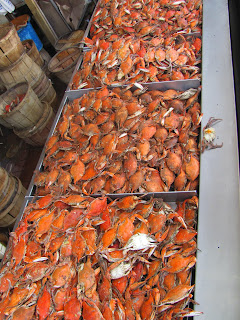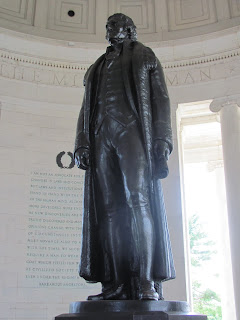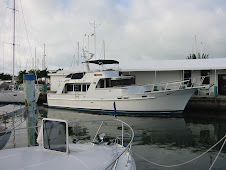Saturday, May 12, 2012
May 3-6, 2012 - Washington, DC
Today we moved to our dock at the Capital Yacht Club. One neighbor was Trade Wind, a 1938 motorsailing ketch.
The brightwork was beautiful on the boat and its three tenders.
As we remembered from our last trip, the floating seafood market was in full swing.
Oh the choices!
All freshly caught, and so tantalizing.
You can get your crabs raw, or steamed as these have been.
Whatever cut of fish you want is here.
And if you need something for the Joe Lewis Arena and a Wings game…..
Even in the urban marinas, wildlife can be found.
Our dock is just a short walk from Washington’s National Mall and Memorial Parks. For generations, millions of people have come here to experience the park’s grandeur and to reflect on what it means to be an American. We went for a walkabout, around the Tidal Basin. Across the water we could see the Jefferson Memorial.
The Washington Monument is the centerpiece of the Mall. Damaged by the magnitude 5.8 earthquake on August 23, 2011, it is currently closed while the National Park Service works on repairs.
A new memorial since we last visited is the Martin Luther King, Jr. Memorial. At the entry portal, two stones are parted and a single stone wedge is pushed forward toward the horizon, the missing piece of what was once a single boulder. The solitary stone is the Stone of Hope, from which Dr. King’s image emerges. He gazes over the Tidal Basin toward the horizon, perhaps seeing a future society of justice and equality, for which he encouraged all citizens to strive.
Behind the statue, Dr. King’s legacy is captured on the Inscription Wall, where fourteen of Dr. King’s most notable quotes are engraved on a 450-foot crescent shaped granite wall.
Next, on to the Franklin Delano Roosevelt Memorial. Roosevelt’s words, associated with great and catastrophic events, are inscribed along the walls, including “Freedom of Speech, Freedom of Worship, Freedom from Want, Freedom from Fear.” Alongside Roosevelt, his beloved Scottish terrier Fala is memorialized, the only presidential pet so honored in the city’s monumental core.
The Memorial, which stands between the Tidal Basin and the Potomac River, also includes a tribute to Eleanor Roosevelt, this statue commemorating her role as First Lady and her later work as United Nations delegate and champion for human rights.
The Washington Monument is reflected in the Tidal Basin.
The Thomas Jefferson Memorial, modeled after the Pantheon of Rome, is America's foremost memorial to our third president and a key landmark in the core of Washington, D.C. The circular, colonnaded structure was designed to synthesize Jefferson's contribution as a statesman, architect, President, drafter of the Declaration of Independence, adviser of the Constitution and founder of the University of Virginia.
Few major changes have been made to the Memorial since its dedication in 1943. The most important change was the replacement of a plaster model statue of Thomas Jefferson by the bronze statue after the World War II restrictions on the use of metals were lifted.
The view from inside the Jefferson Memorial, out across the Tidal Basin, shows the Washington Monument.
For the four days we were in Washington, President Obama’s helicopter kept flying overhead. He certainly is a busy man.
We spent quality time with our friends Janet and Jim Sass, from Annandale, Virginia. They were a 20-minute drive from the Yacht Club, so we saw them every day, and had wonderful meals and evenings together.
Some of that wonderful seafood went into the meals. Here, Jerry removes beards from fresh mussels.
Then, the girls cooked up bouillabaisse.
More touring came the following day, to the Smithsonian National Museum of American History.
While this is now considered an antique, we recall similar computer models.
The transportation museum is funded by General Motors.
First Lady Michelle Obama’s inaugural ball gown was on display.
And President Eisenhower’s summer uniform.
Among the Smithsonian’s the most treasured items is Abraham Lincoln’s top hat, which he had with him when he was assassinated.
At the Smithsonian National Museum of Natural History, we looked down on Ocean Hall.
The exhibit of the Smithsonian’s annual nature photography contest winners was one of our favorites. We recognized these Roseate Spoonbills, native to the Florida Everglades.
The Smithsonian’s benefactor, Englishman James Smithson, never visited the U.S., yet he endowed this great institution “for the increase and diffusion of knowledge.” Founded in 1846, the Smithsonian is now the world's largest museum and research complex, consisting of 19 museums and galleries, the National Zoological Park and nine research facilities.
The U.S Capitol, on the east end of the Mall, makes a graceful transition to the mall through a series of terraces.
Subscribe to:
Post Comments (Atom)

































No comments:
Post a Comment